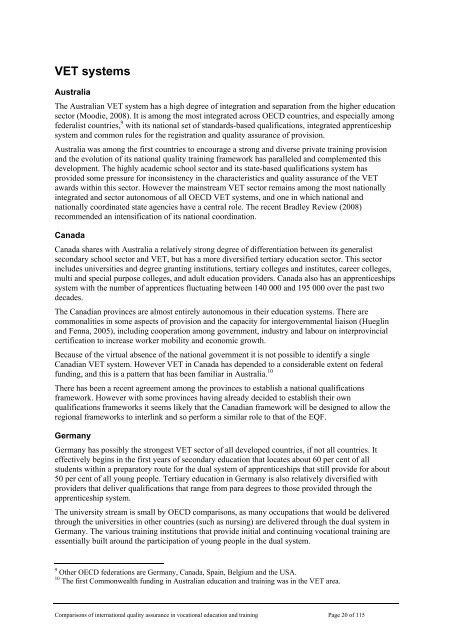Review - Department of Innovation, Industry, Science and Research
Review - Department of Innovation, Industry, Science and Research
Review - Department of Innovation, Industry, Science and Research
Create successful ePaper yourself
Turn your PDF publications into a flip-book with our unique Google optimized e-Paper software.
VET systems<br />
Australia<br />
The Australian VET system has a high degree <strong>of</strong> integration <strong>and</strong> separation from the higher education<br />
sector (Moodie, 2008). It is among the most integrated across OECD countries, <strong>and</strong> especially among<br />
federalist countries, 9 with its national set <strong>of</strong> st<strong>and</strong>ards-based qualifications, integrated apprenticeship<br />
system <strong>and</strong> common rules for the registration <strong>and</strong> quality assurance <strong>of</strong> provision.<br />
Australia was among the first countries to encourage a strong <strong>and</strong> diverse private training provision<br />
<strong>and</strong> the evolution <strong>of</strong> its national quality training framework has paralleled <strong>and</strong> complemented this<br />
development. The highly academic school sector <strong>and</strong> its state-based qualifications system has<br />
provided some pressure for inconsistency in the characteristics <strong>and</strong> quality assurance <strong>of</strong> the VET<br />
awards within this sector. However the mainstream VET sector remains among the most nationally<br />
integrated <strong>and</strong> sector autonomous <strong>of</strong> all OECD VET systems, <strong>and</strong> one in which national <strong>and</strong><br />
nationally coordinated state agencies have a central role. The recent Bradley <strong>Review</strong> (2008)<br />
recommended an intensification <strong>of</strong> its national coordination.<br />
Canada<br />
Canada shares with Australia a relatively strong degree <strong>of</strong> differentiation between its generalist<br />
secondary school sector <strong>and</strong> VET, but has a more diversified tertiary education sector. This sector<br />
includes universities <strong>and</strong> degree granting institutions, tertiary colleges <strong>and</strong> institutes, career colleges,<br />
multi <strong>and</strong> special purpose colleges, <strong>and</strong> adult education providers. Canada also has an apprenticeships<br />
system with the number <strong>of</strong> apprentices fluctuating between 140 000 <strong>and</strong> 195 000 over the past two<br />
decades.<br />
The Canadian provinces are almost entirely autonomous in their education systems. There are<br />
commonalities in some aspects <strong>of</strong> provision <strong>and</strong> the capacity for intergovernmental liaison (Hueglin<br />
<strong>and</strong> Fenna, 2005), including cooperation among government, industry <strong>and</strong> labour on interprovincial<br />
certification to increase worker mobility <strong>and</strong> economic growth.<br />
Because <strong>of</strong> the virtual absence <strong>of</strong> the national government it is not possible to identify a single<br />
Canadian VET system. However VET in Canada has depended to a considerable extent on federal<br />
funding, <strong>and</strong> this is a pattern that has been familiar in Australia. 10<br />
There has been a recent agreement among the provinces to establish a national qualifications<br />
framework. However with some provinces having already decided to establish their own<br />
qualifications frameworks it seems likely that the Canadian framework will be designed to allow the<br />
regional frameworks to interlink <strong>and</strong> so perform a similar role to that <strong>of</strong> the EQF.<br />
Germany<br />
Germany has possibly the strongest VET sector <strong>of</strong> all developed countries, if not all countries. It<br />
effectively begins in the first years <strong>of</strong> secondary education that locates about 60 per cent <strong>of</strong> all<br />
students within a preparatory route for the dual system <strong>of</strong> apprenticeships that still provide for about<br />
50 per cent <strong>of</strong> all young people. Tertiary education in Germany is also relatively diversified with<br />
providers that deliver qualifications that range from para degrees to those provided through the<br />
apprenticeship system.<br />
The university stream is small by OECD comparisons, as many occupations that would be delivered<br />
through the universities in other countries (such as nursing) are delivered through the dual system in<br />
Germany. The various training institutions that provide initial <strong>and</strong> continuing vocational training are<br />
essentially built around the participation <strong>of</strong> young people in the dual system.<br />
9 Other OECD federations are Germany, Canada, Spain, Belgium <strong>and</strong> the USA.<br />
10 The first Commonwealth funding in Australian education <strong>and</strong> training was in the VET area.<br />
Comparisons <strong>of</strong> international quality assurance in vocational education <strong>and</strong> training Page 20 <strong>of</strong> 115
















